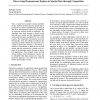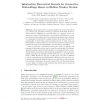613 search results - page 101 / 123 » Learning the Structure of Linear Latent Variable Models |
ICML
2000
IEEE
14 years 8 months ago
2000
IEEE
If all features causing heterogeneity were observed, a mixture of experts approach (Jacobs et al., 1991) is likely to be superior to using a single model. When unobserved or very n...
ICML
2007
IEEE
14 years 8 months ago
2007
IEEE
Given a large, real graph, how can we generate a synthetic graph that matches its properties, i.e., it has similar degree distribution, similar (small) diameter, similar spectrum,...
SSPR
2010
Springer
13 years 5 months ago
2010
Springer
Many approaches to learning classifiers for structured objects (e.g., shapes) use generative models in a Bayesian framework. However, state-of-the-art classifiers for vectorial d...
ICML
2009
IEEE
14 years 8 months ago
2009
IEEE
We propose a nonparametric extension to the factor analysis problem using a beta process prior. This beta process factor analysis (BPFA) model allows for a dataset to be decompose...
UAI
2008
13 years 9 months ago
2008
We introduce a new type of graphical model called a `cumulative distribution network' (CDN), which expresses a joint cumulative distribution as a product of local functions. ...


